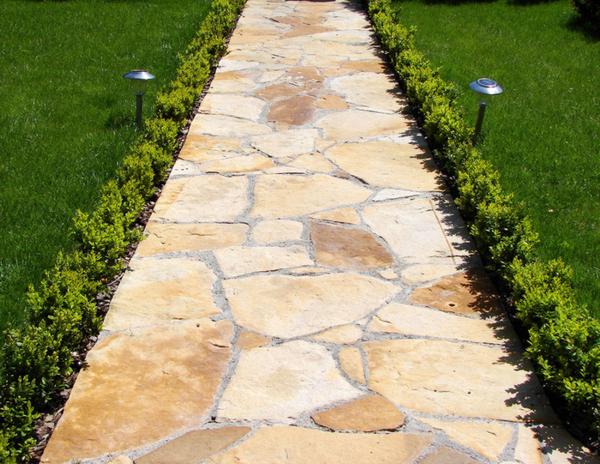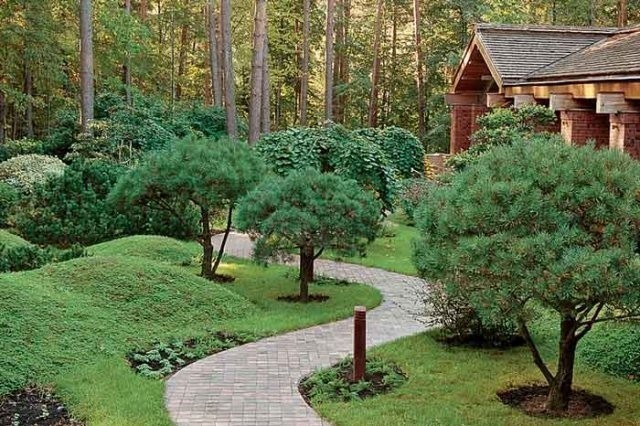Search
Login
We choose material for garden paths on a personal plot, useful tips
A successful architectural solution of a suburban area directly depends on the type of properly designed garden paths. With their help, the non-residential territory of the site can be divided into so-called zones. In turn, the zones can be designed for pedestrian or car traffic, they can also be interconnected or disconnected. The installation of garden paths and their location often depends on where and how the household and utility buildings are built, where the territory is designated for parking, where a recreation area is provided on the plot area.
Content
- Material for garden paths choose practical
- The shape and size of the tracks, how to choose a place for the track
- Materials for paving garden paths video
- Sand Garden Paths
- Tracks of slag, rubble and brick fight
- The advantages of concrete tracks
- Tile for garden paths video
- If you want to choose the best material for garden paths - buy a clinker
- Why do I need a geogrid
- Form for making garden paths video
- Garden paths from improvised materials
- Wooden garden paths
Material for garden paths choose practical

Garden paths in fact are not only fragments of decor, but also operational objects. They will be used in different ways and in different climatic conditions. Therefore, during the construction of these design fragments, it is necessary to seriously approach the issue: what material to choose for garden paths? Of course, the material needs durable, reliable and high-quality.
Installation of low-quality materials will lead to quick damage to the tracks. Consequently, urgent repairs will be necessary, which will take a lot of physical strength and require additional purchase of material for garden paths.
The shape and size of the tracks, how to choose a place for paving the track
As for the size of the tracks, the best option would be those that are not too large, and most importantly - practical. The width of the track, first of all, depends on its specific purpose.

Almost always, the shortest path is on the way from the entrance to the site to the entrance to the house. Authentic and more sinuous paths are located on the way to the vegetable garden, to outbuildings and utility rooms, to the territory intended for recreation. The narrowest paths, about forty centimeters, will be most practical to do in the garden, between the beds. But the width of the path to the house should be much wider, about one meter. Such a width will be enough so that you can walk along it together.

If desired and necessary, paths to the house can be arranged in the form of an entrance. It will look in the form of two equal in width, about sixty centimeters, tracks. Other paths proposed for walking, for example in the garden or near a chic club with fragrant flowers, can be made about seventy centimeters wide.

When placing paths near trees, you need to remember that trees will grow over time, and therefore their root system will also increase. Of course, the crown will have to be cut from time to time, so that it does not interfere with walking. But a more developed root system will destroy the garden path. To avoid this problem, you need to place it at a safe distance from the tree trunk.
There is another nuance in the construction of paths - ensuring the flow of water from the area of \u200b\u200bthe path. This can be achieved as follows: make both edges of the track with a slight slope to the outside.
Materials for paving garden paths

The main materials for laying garden paths are brick, concrete slabs or concrete. Quite often, wood, gravel, small pebbles and gravel are used. First of all, choosing the source material for the track, you need to proceed from its purpose and, of course, appearance.
One of the simplest and least budgetary ways to make a track is to make it with sand. This material absorbs moisture well. But when the temperature drops, he unfortunately loses this quality. Another operational disadvantage of this material is the following fact - the sandy base serves as a good basis for the abundant growth of various weeds. They will have to constantly fight and, accordingly, constantly add sand to the track. Garden paths of this kind are rather capricious in leaving, which is a very inconvenient moment.
Sand Garden Paths

If, nevertheless, it was decided to make garden paths with your own hands from sand material, then experts advise you to familiarize yourself with the following practical tips:
- the first step is to dig a trench, about 20 centimeters in depth, and enclose it around the edge with pegs;
- the next step is to level and tamp the base of the resulting trench;
- then a layer of about ten centimeters thick, consisting of gravel, brick, crushed stone, is poured into the bottom of the trench and well compacted;
- then another layer is poured, five centimeters thick and consisting of the same composition of materials;
- further, the formed layers are watered with a sufficiently large amount of water and sand is poured, if possible, it would be better to mix sand with stone crumb or cement initially;
- after all of the above, a good tamper will not hurt.
In order to avoid getting soil onto the track and preserve the original shape, it is surrounded by a border made of concrete, stone or brick. The maximum height of the curb should not exceed five centimeters.
Tracks of slag, rubble and brick fight

Also low-budget paths will be made of crushed stone, brick fight or slag. Step-by-step instructions for the production of tracks from the above materials:
- dig a trench and pour a layer of broken brick, rubble or slag on its bottom;
- pour plenty of water and tamp well;
- the second layer - fine slag, a thickness of about five centimeters, pour water and tamp;
- the third layer is a thickness of two centimeters, clay, gravel, or slag material.

Garden paths made of such material require much less attention to themselves in terms of care.
The advantages of concrete tracks
The most practical and durable tracks will be made of concrete. Basically, this type of track is made for access to a specific place, house or garage. In cases where the proposed track is uniquely designed for driving, the depth of the trench under it must be made at least fifty centimeters.
If the planned path is intended only for pedestrian movements, then trenches with a base depth of at least ten centimeters will be enough. On such paths, it is imperative that one of the parties make a slight deviation to ensure water flow. After a quality ramming, the concrete is poured with a thickness of about six centimeters. Then carefully align it with a board or rail.
The concrete layer needs to be compacted qualitatively - this prevents the formation of cracks, and so, after all leveling and tamping operations are completed, moisten with water and cover to dry it more slowly. The concrete track can be modified. For example, to complete the drying process, apply an interesting drawing or make a print of the ornament you like.

If you use a brush and walk it on concrete that has not yet hardened, then its surface will become rough to the touch. Such a surface will be very convenient and practical in the winter season, when there is a high probability of ice. The gap between the strips is eliminated using asphalt.
The option is also quite applicable when a very limited amount of time is allocated for building a concrete track, dig a trench twenty-five centimeters deep, but be sure to put reinforcement in the concrete mass for special strengthening. Concrete garden paths will last a long amount of time and will have a very good appearance.
Tile for garden paths

Also, the coating for garden paths can be made of concrete slabs. They have no bad appearance. The most suitable form for the manufacture of garden paths will be a slab in sizes 40x20, 40x40, 40x60. The surface of the plates, at the request of the buyer, can be either flat or with prints of various ornaments. The base under the path of such material is covered with sand, and then the plates are mounted.

This is done only if the track is designed for walking. When laying the plates, between them without fail leave gaps of about five centimeters. Then the resulting gaps are either covered with earth or decorated with grass. If such a path is intended for the movement of vehicles, then the slabs should be placed on a solution of concrete with a thickness of about eight centimeters. And the solution itself is placed directly on the crushed stone layer.
There are options when the slabs on the sand cushion move. This is the problem to be solved: the plate is removed, the required amount of sand is added, the plate is put in place, the level is checked for horizontalness and, with the help of a rubber hammer, it is deepened by the required number of centimeters. Gaps are filled with sand and moistened well.
If you want to choose the best material for garden paths - buy a clinker

Roads designed for access are often made paved. In other words, paved paths are roads made of road brick, that is, clinker. Similar tracks will not look bad in the variant when the lower part of the house has a brick design. They interestingly diversify the style of construction and garden. Clinker is a rough material to the touch, four centimeters thick. Since this material is not cheap, it is not very often used in construction. Much more often resort to the use of paving slabs. It is she who is considered the more frequently used material for the construction of garden paths.

Paving slabs can be of different sizes: width from 9 to 20 centimeters, length from 10 to 28 centimeters, thickness from 4 to 10 cm. For the improvement of paths, it will be enough to lay a tile six centimeters thick, and eight centimeters thick will be suitable for paths intended for entrance . Today, manufacturers offer the buyer tiles of various shapes and colors. There are species that are covered with natural chips. You can make a path both plain and multi-colored, creating fancy pictures.
Why do I need a geogrid
To lay the paving slabs you will need a solution of cement and sand. When you need to make a track for driving vehicles, you also need to use rubble. You need to know that the track, during the construction of which crushed stone was used, may eventually shrink during operation. But to solve this problem there is a tool - geogrid. In shape, it resembles a honeycomb. It is made from polyethylene tapes by the process of fusion. Manufacturers produce such gratings of different heights. In order to understand what kind of height is needed in a particular case, you need to know what kind of load the track is expecting in the future. Such gratings are considered one of the best and most reliable options to prevent the subsidence of gravel.

Lattices of several colors are on sale - black, green and sand. A track with a geogrid is mounted as follows:
- directly on a layer of gravel lay a lattice and fasten with special pegs;
- the next layer after it is poured from crushed stone or stone;
- then geotextiles, which will remarkably prevent the process of leaching sand;
- the next step is a layer of cement composition;
- the final step is paving slabs.
Form for making garden paths

The form is a kind of stencil made of plastic, quite often used in the creation of landscape design. Having bought this form, almost anyone will be able to easily and personally create an interesting path made of concrete on their personal plot.

The described process does not require large financial investments.

The meaning of working with the form is as follows:
- the place where the track will be located is determined
- cement mortar is mixed;
- a form is set to a specific place;
- a solution is laid out in it and carefully leveled with a rail;
- now you can rest and wait about half an hour;
- the last step is to stretch the mold with maximum accuracy.
A day later you can walk along the path.
Garden paths from improvised materials

Garden paths can be made of a variety of materials. For example, if you pave a path of stone, stone slab or large pavers and do not observe the rules of symmetry during installation, you will get a very original element of decor. Asymmetric styling will add variety. The main thing in this work is to remember that the materials used must be in harmony with each other. Alternatively, paths located not in the area of \u200b\u200bparticular movement activity can be advantageously decorated with ground cover plants. They will grow and give the opportunity to enjoy a soft flowering carpet, which, to everything else, requires minimal attention in terms of care.
Wooden garden paths

When choosing a place for a track of this kind, you need to remember that it must always be dry. Directly to mount such a path, you will need bars at least fifteen centimeters high, planed from fairly hard wood. Before starting work, the wood must be treated with an antiseptic solution. Such processing will reliably protect against possible decay processes. The base of the wood path should be sandy.

When laying, alternating bars of different sizes, you can get an extraordinary pattern. After laying, the path is covered with sand and watered. Thus, the sand will fill all the gaps formed. Provided that all of the above recommendations are met, the final result will long please the owners of the personal plot.





